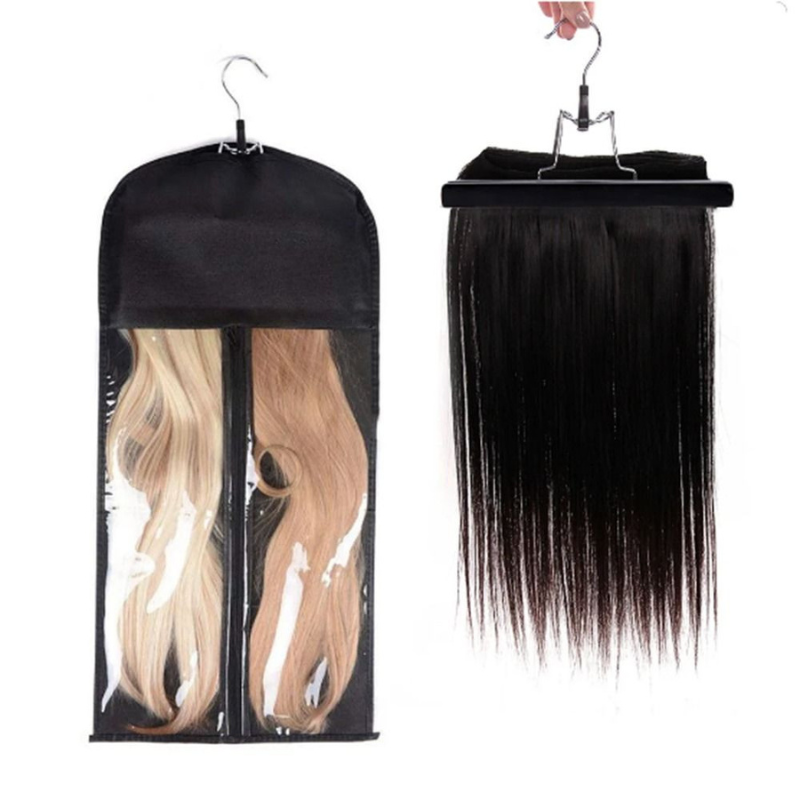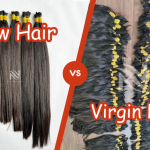Hair Care Tips
How I Properly Care for Human Hair Extensions
After spending a lot of time and effort to find the right hair extensions, now it’s time to learn how to care for and maintain it. To keep your hair in the best condition as when you first bought it, we will share with you some special notes when caring for hair extensions.
1. Why You Need to Care for Hair Extensions
Human Hair extensions need the same care as your natural hair. However, hair extensions do not receive nutrition from the scalp, so if not properly cared for, hair extensions can become dry, brittle, fall out easily and are no longer as smooth as before.
To keep hair extensions beautiful, smooth and durable, proper care will help you maintain the perfect appearance of hair extensions for a long time. If well cared for, the life of hair extensions can be up to 2 or 3 years depending on the type.
2. How to Care for Human Hair Extensions Properly
2.1. Washing and Conditioning
Maintaining clean, well-moisturized hair extensions is the foundation of long-lasting, beautiful results. Whether you’re wearing clip-ins, tape-ins, or a full weave, proper washing and conditioning will preserve softness, shine, and manageability.
How Often Should You Wash Hair Extensions?
Unlike natural hair, extensions do not benefit from the scalp’s natural oils. This means they need less frequent washing—but higher-quality care. In general:
-
Clip-ins: Wash after every 10–15 wears or when product buildup is noticeable.
-
Permanent extensions (tape-in, keratin, weave): Wash every 7–10 days depending on your hair type, activity level, and styling habits.
Choosing the Right Products
Use sulfate-free, alcohol-free shampoos and conditioners. Harsh ingredients can strip moisture, causing the extensions to become dry, brittle, or tangle-prone.
Recommended:
-
pH-balanced formulas
-
Lightweight, moisturizing conditioners
-
Leave-in treatments (for mid-length to ends only)
Avoid:
-
Clarifying shampoos (unless necessary to remove buildup)
-
Heavy silicones that coat hair and weigh it down
💡Use product that matches your hair’s porosity for best results.
How to Wash Hair Extensions Properly
Follow these steps for optimal results:
-
Detangle first: Use a wide-tooth comb or loop brush to gently remove any knots before getting the hair wet.
-
Use lukewarm water: Soak the hair and apply shampoo in a downward motion—never rub or twist.
-
Rinse thoroughly: Ensure no shampoo residue remains, especially near the attachment points.
-
Condition from mid-length to ends: Avoid the root area to prevent slippage (important for tape-in or keratin bonds).
-
Optional deep treatment: Once every 2–3 weeks, use a hydrating hair mask to restore elasticity and softness.
Rinse & Blot Gently
After conditioning:
-
Rinse with cool water to seal the cuticle.
-
Gently squeeze excess water (do not wring).
-
Pat dry with a microfiber towel to reduce friction and frizz.
👉Watch the video for detailed instructions on how to wash and condition hair extensions
2.2. Brushing and Detangling
Tangled hair extensions not only look unkempt—they also lead to shedding, breakage, and damage to your natural hair. Regular, gentle brushing is essential to keeping extensions smooth and intact.
Why Detangling Is So Important
Hair extensions don’t receive natural oils from the scalp, so they’re more prone to dryness and friction. This can cause matting, especially around the nape and ends. Consistent detangling prevents:
-
Unwanted knots and tangles
-
Excessive shedding
-
Damage to the attachment points (keratin bonds, tapes, wefts)
What Tools to Use
Not all brushes are extension-safe. Use tools designed specifically for detangling and protecting the bonds.
Recommended tools:
-
Loop brush: No bristles—great for tape-ins and keratin bonds
-
Wide-tooth comb: Gentle for curly or wavy textures
-
Soft-bristle brush: Suitable for clip-ins and wigs
Avoid:
-
Regular paddle brushes with plastic ball tips (they can catch and pull)
-
Fine-tooth combs near the root area
How to Brush Hair Extensions Correctly
-
Start from the bottom: Gently work your way up, inch by inch. This reduces pulling and breakage.
-
Hold at the base: Use your hand to support the hair near the attachment point. This prevents stress on your natural strands.
-
Brush twice a day: Once in the morning and once before bed to prevent tangles overnight.
-
Use a detangling spray (optional): Ideal for curly or wavy textures or during humid weather.
Special Tips for Different Types
-
Clip-ins: Always detangle before and after use. Store them neatly to avoid matting.
-
Tape-ins and keratin bonds: Avoid brushing the root area too aggressively.
-
Wavy or curly extensions: Finger-comb when dry, and use a wide-tooth comb only when damp with conditioner.
2.3. Drying and Heat Styling
Proper drying and heat styling can make a significant difference in the lifespan and appearance of your hair extensions. Unlike natural hair, extensions require extra care when exposed to heat.
Towel-Drying Do’s and Don’ts
Do:
-
Pat dry with a soft microfiber towel to absorb excess water without roughing up the cuticle.
-
Gently squeeze out moisture—don’t rub.
Don’t:
-
Twist or wring out the hair
-
Use a regular cotton towel, which causes friction and frizz
Air Drying vs. Blow Drying
Air drying is the safest method when time allows, especially for curly or wavy textures. It helps retain the integrity of the bonds and prevents dryness.
Blow drying is acceptable when done with care:
-
Always apply a heat protectant spray
-
Use a low to medium heat setting
-
Direct the airflow downward to maintain smooth cuticles
-
Use a diffuser attachment for curly or wavy hair to maintain shape
💡 Pro Tip: Never blow-dry bonded areas (like tape or keratin tips) on high heat as it can weaken the adhesive or cause slippage.
Safe Heat Styling Practices
Whether you’re curling, straightening, or waving your extensions, be mindful of the temperature.
Recommended max temperatures:
-
120–150°C (250–300°F) for finer hair textures
-
150–180°C (300–350°F) for thicker textures
Best practices:
-
Use ceramic or tourmaline tools to minimize damage
-
Always section the hair before styling
-
Never apply heat on wet or damp extensions (unless using heat-safe steam tools)
Styling Frequency
Limit heat styling to a few times per week. Consider heatless styling methods—like braids, flexi rods, or satin rollers—especially for long-term extension wearers.
2.4. Night Care Routine
Taking proper care of your human hair extensions at night is essential to prevent tangling, matting, and unnecessary wear. A few simple steps can extend the lifespan of your extensions and help them look flawless each morning.
Brushing Before Bed
Always brush your hair before going to sleep to remove tangles and distribute natural oils:
-
Use a wide-tooth comb or a loop brush designed for extensions
-
Start from the ends and work your way up
-
Be gentle near attachment points like clips, tapes, or keratin bonds
Protective Hairstyles
Leaving your hair loose overnight can lead to friction and breakage. Instead, secure it in a protective style:
-
Loose braid or twist
-
Low ponytail with a silk scrunchie
-
For curly or textured extensions, consider pineappling to preserve curls
Use Silk or Satin
Investing in silk or satin pillowcases or a sleep bonnet is a game-changer:
-
Reduces friction that causes frizz and tangles
-
Helps retain moisture in both natural hair and extensions
-
Extends the lifespan of your style and texture
💡 Cotton pillowcases absorb moisture and create static, which is why they’re not recommended for those wearing extensions regularly.
Extra Care for Clip-In Extensions
Clip-ins should always be removed before bed. Sleeping with them can:
-
Damage your natural hair
-
Cause unnecessary tangling or shedding
-
Reduce their lifespan dramatically
Gently unclip them, brush each piece, and store them properly (see next section).
👉15 Best Ways to Keep Hair Extensions Straight Overnight
2.5. Store When Not in Use
Proper storage of human hair extensions—especially clip-ins and wigs—is crucial to maintaining their shape, texture, and hygiene. Whether you’re storing them overnight or between uses, the right storage method protects your investment and ensures your extensions stay in optimal condition.
Brush Before Storing
Always detangle your extensions before placing them in storage:
-
Use a loop brush or wide-tooth comb
-
Start at the ends and move upward
-
Remove any styling products or buildup with a light spritz of leave-in conditioner, if necessary
Use a Storage Bag or Box
Store your clip-ins and wigs in a breathable fabric bag, extension hanger, or original packaging:
-
Keeps hair protected from dust, moisture, and tangling
-
Preserves the style and texture
-
Helps maintain hygiene and shape
🧳 Hair extension storage bags with hangers are ideal for clip-ins—they prevent creases and are perfect for travel.

Avoid Plastic Bags
Do not store human hair extensions in airtight plastic bags:
-
Lack of airflow can lead to mildew if there’s any moisture
-
Can cause static buildup or unnatural flattening
Keep in a Cool, Dry Place
Store your extensions away from direct sunlight, humidity, or heat sources. Ideal storage conditions:
-
Room temperature
-
Away from radiators, windows, and bathrooms
-
Inside a drawer or closet is often perfect
Wig Stands for Full Units
If you wear full wigs, invest in a wig stand or mannequin head:
-
Helps maintain the wig’s shape and structure
-
Allows for air circulation
-
Prevents tangling or crushing
💡 Pro tip: If your wig has curls or waves, use a stand with a satin cover to preserve the style.
2.6. Salon Maintenance Schedule
Even with the best at-home care, professional maintenance is essential to extend the life and appearance of your hair extensions—especially for semi-permanent methods like tape-ins, keratin bonds, or sew-ins.
Why Professional Check-Ups Matter
Routine visits to the salon ensure:
-
Extensions are secure and aligned
-
Natural hair health is monitored
-
Repositioning or tightening is done as needed
These visits help detect any issues early—such as matting at the roots or tension spots—that could damage your scalp or natural hair.
Recommended Schedule by Extension Type
Here’s a general guideline for how often you should visit the salon:
| Extension Type | Maintenance Interval |
|---|---|
| Tape-In Extensions | Every 6–8 weeks |
| Keratin Bonds | Every 3–4 months |
| Sew-In Extensions | Every 6–8 weeks |
| Micro-Ring/I-Tip | Every 6–8 weeks |
| Clip-Ins | As needed (for trims or styling) |
✂️ Regular trimming—every 6–10 weeks—keeps both natural and extension hair looking fresh and full.
Color Matching & Re-blending
During maintenance visits, your stylist can also:
-
Blend regrowth or adjust root color
-
Tone or refresh color-treated extensions
-
Check for any tonal mismatch as your natural hair changes
Deep Treatments & Repairs
Some extensions, especially virgin or raw hair types, benefit from occasional deep conditioning treatments. A salon professional can:
-
Apply treatments evenly and rinse thoroughly
-
Use heat or steam for deeper absorption
-
Repair dryness or styling damage without overloading the hair
💡 Ask your stylist to use sulfate-free, extension-safe products during treatments.
Conclusion
Proper care of your human hair extensions is an important factor in maintaining beautiful, bouncy and healthy hair. By using the right hair care products and adopting good habits in washing, drying, brushing and styling, your hair extensions will always retain their natural beauty and not be damaged.
Remember, caring for your hair extensions not only helps you maintain long-term beauty but also protects the health of your real hair. Don’t forget to choose quality products and take the time to care for your hair every day.





